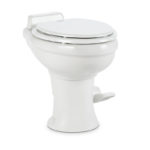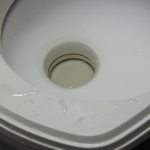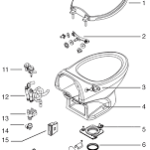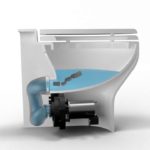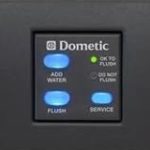RV Toilets/Black and gray water tanks
An obviously important part of your RV is the “water closet”, the “loo”, the “privy”, your RV toilet. In this section we are going to work to take some of the mystery out of this mechanisms so that you can properly take care of it and have it be a dependable part of your home on wheels.
There is no question that the typical RV toilet is different in many ways from the toilet you have in your home. It is definitely more complicated, more delicate, works in different ways and requires a totally approach to maintenance and repair.
I meet RVers all the time who approach the maintenance of an RV toilet like a home toilet, using harsh chemicals to clean and maintain it and its partner, the black tank.
In this section we are going to discuss both the RV toilet and the black water holding tank, how they work, how they are different from brick and sticks home toilets, and most importantly how you take care of both.
The RV Toilet
RV toilets basically fall into two types, the regular manual toilet with a pedal on the front or side and a mascerator toilet which is an electrical toilet.
The regular, manual toilet :
- has a curved piece in its center which stays up against a rubber gasket when the toilet is not operating.
- usually has about an inch of water in it at all times to prevent black tank gasses from coming out into the room.
- when the flush pedal is pushed down, the valve opens to the black tank, and water from either the fresh water tank or the local water source is allowed into the tank to rinse the bowl. The inlet valve that controls when the water enters the bowl, in my opinion is sometimes the source of leaking outside the toilet.
- has many parts, several rubber gaskets and valves.
- is much more complicated and delicate that your regular house toilet.
- the parts often the most susceptible to damage and in need of replacement are the rubber gaskets.
- It is our recommendation that you never use any chemicals in or on an RV toilet that are not specifically made for it. This means no bleach, no toilet “wands”, no Clorox tabs or any products made for the regular sticks and bricks toilet.
- There are a number of products available that you can use to clean and disinfect your toilets that will work with the bacteria in the black tank. We have tried many of them but have found this one works well.
- You should also never use a stiff brush of any kind on the area around the valve blocking the inlet to the black tank. Brushing can damage that gasket.
This leads us to some important things surrounding the black water tank.
- there are two types of holding tanks in an rv, the black water tank and the gray water tank. The black water tank holds the outflow from the toilets only. The gray water tank is water from showers and sinks.
- the the early days of RVing the chemical formaldehyde was the main component chemical used in holding tanks to reduce the smell. It simply preserved the contents of the tank and did not allow bacteria to grow.
- that chemical has now for the most part been replaced with considerably more environmentally friendly alternatives that work much better and are better for the environment.
- these new alternatives are based on a bacteria model which encourages the break down of the solids and paper in the black tank. This process allows more complete emptying of the tank, and helps preserve sensor operation.
- we strongly recommend that you do not use tank additives that have formaldehyde or other chemicals. You should only use additives that are based upon the bacteria model.
- this is an example of this type of product, we use it and recommend it.
The second type of RV toilet is the macerating toilet.
- This type of toilet is typically used in an RV where the toilet is a ways from the inlet of the black water tank.
- This toilet has an electric motor that basically grinds up waste and paper, adds considerable water and then forces it down the piping to the black water tank.
- Macerating toilets use considerably more water than a manual toilet.
- They also can glog some what easier than a manual toilet.
- All the same cautions described above apply to macerating toilet.
At this point i would like to discuss toilet paper. Lovely topic I know but if you are a member of any only like RV group it is truly amazing the types of discussion that can ensue when this subject is brought up. There are two extremes of the discussion.
At one end of the spectrum are those that believe that you should not put any toilet paper in the system and use covered waste basket for toilet paper. At the other end are those that believe any regular toilet paper is perfectly fine.
It is our opinion and experience that neither of these views make any sense.
- You do not have to buy special RV toilet paper.
- Any single ply rapidly dissolving toilet paper is fine.
- The absolute best way of determining whether a paper is going to dissolve and is suitable is to take a few sheets, place them in a glass of water. Then putting your hand over the glass, shake it for a few seconds. If the paper disintegrates quickly it will work in your RV toilet.
- You should never put any thing else in your RV toilet. Do not put sanitary wipes in your RV toilet.
One final word concerning the gray water tank.
- In our motorhome we leave the gray water tank valve open and allow water to flow out as it comes in from sinks and showers.
- We do not put cooking oil or grease of any kind into our gray water tank
- We have a fine strainer in our kitchen sink to prevent food particles of any size from entering the tank.
- A day or so before we are going to empty the black water tank, we close the gray water tank to allow water to build up
- When we empty the black, we keep the gray closed. We never open both at once so that we do not contaminate the gray tank with any black water.
- When we have finished emptying the black water tank and flushed the tank for 20 minutes with fresh water, we then close the black tank valve
- At that point we open the gray water valve allowing the gray water to purge the sewer hose going from the RV to the sewer inlet.
Directory of Posts:
To Ask a Question click here
To Subscribe to our BLOG click here
